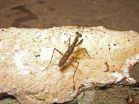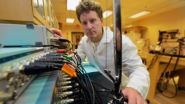(Press-News.org) STANFORD, Calif. — California sea lions exposed to a toxin in algae develop a form of epilepsy that is similar to one in humans, according to a new study led by Stanford University School of Medicine researchers.
Every year, hundreds of sea lions wash up along the California coast, suffering seizures caused by exposure to domoic acid, a neurotoxin that can produce memory loss, tremors, convulsions and death. Domoic acid is produced by algae blooms that have been proliferating along the coast in recent years, accumulating in anchovies and other small fish that the sea lions feed on, said Paul Buckmaster, PhD, DVM, professor of comparative medicine at Stanford.
Buckmaster and his colleagues studied the brains of affected sea lions and found they had a pattern of damage in the hippocampus — the brain's memory center — much like that in humans with temporal lobe epilepsy.
"We found there was a loss of neurons in specific patterns that closely matched what is found in people," he said. "And there is synaptic reorganization — a rewiring of surviving neurons. This also matches what is found in humans with temporal lobe epilepsy."
He said further studies in the animals could help in developing better treatments for them, as well as for their human counterparts.
Buckmaster is lead author of the study, which will be published online March 19 in the Journal of Comparative Neurology.
Temporal lobe epilepsy is one of the most common forms of epilepsy in humans and has no cure. It typically begins with a seizure caused by an insult to the brain, such as head trauma, high fever or lack of oxygen. Months or years later, it progresses into epilepsy, with periodic seizures that may be treated with anti-convulsive medication or, in some cases, surgery.
There is one documented case of a patient who was found to have developed temporal lobe epilepsy following exposure to domoic acid. The 84-year-old Canadian was one of more 250 people who became ill in 1987 after eating mussels from Prince Edward Island that were found to be contaminated with domoic acid. The man, who suffered nausea, vomiting, coma and convulsions, initially recovered but was diagnosed a year later with temporal lobe epilepsy; he died some two years later of pneumonia. Three other Canadians died in the mussel incident as a result of domoic acid poisoning.
In sea lions, the first link between domoic acid and epilepsy was established in 1998, when some 400 animals washed ashore in California's Monterey Bay on Memorial Day weekend. Some had died, while others were in the throes of seizures, weaving their heads, flailing about and scratching themselves in an odd way. About 100 of the animals were rescued by the Marine Mammal Center in Sausalito, where experts were at a loss to explain the animals' bizarre behavior, said Frances Gulland, PhD, DVM, senior scientist at the center and co-author of the current study.
She contacted Christopher Scholin, PhD, now president of the Monterey Bay Aquarium Research Institute, who discovered the bay waters had the highest levels of domoic acid ever recorded, she said. Blood and urine samples from the sea lions confirmed they had domoic acid poisoning. The researchers documented their findings in a 2000 Nature paper.
Since then, Gulland said a few hundred sea lions with epilepsy have been rescued every year by the mammal center, and about half respond to treatment with anti-convulsive therapy. But some suffer from seizures that may continue for hours, causing extensive brain damage. These animals have no hope for recovery and have to be euthanized.
In these cases, mammal center officials turn to Buckmaster, a veterinarian who is an expert in epilepsy in animals. For the past four years, he has been working on studies of the epileptic sea lions, examining samples of their brain tissue to better understand what underlies the disease.
In the current study, he and his colleagues retrieved samples of tissue from the hippocampus, which they cut into thin slices and then stained so that the neurons could be viewed under a microscope. They collected tissues from 14 sea lions with epilepsy and compared them with similar samples from nine without epilepsy who had died of other causes, such as cancer, infection or shark bite wounds.
The animals with epilepsy had lost about 50 percent of the neurons in the hippocampus, similar to what is seen in people with temporal lobe epilepsy, Buckmaster said. The researchers observed another striking similarity: In most cases, the hippocampus on only one side of the brain in the sea lions showed any signs of damage.
"That was really surprising," Buckmaster said. "That is what you find in people — 80 percent of the time the damage is just on one side."
In rats and mice, which are the models typically used in epilepsy studies, injury is seen in the hippocampus of both sides of the brain, he said.
The results are curious, as sea lions ingest the toxin throughout their bodies, he said. "Why would there be damage only on one side?"
He speculated that it could be related to the size and structure of the brain. Like the human brain, the sea lion brain is significantly larger than a rodent brain — 700 times larger than a mouse brain and 180 times larger than a rat brain — and contains many more neurons. However, the average number of synapses — connections between nerve cells — per neuron is roughly the same in rodents and humans. Without more synapses for each neuron, the probability of any two neurons in the large brain being connected must be lower than it is in the small brain, Buckmaster surmised. So this relative lack of interconnectivity in human and sea lion brains could be why damage remains localized to a specific area, he said. (The number of synapses hasn't been measured in sea lions, though it seems reasonable to speculate that they would have a similar ratio of synapses per neuron, he said.)
The researchers also noticed a pattern of rewiring in the brains of the epileptic sea lions that is similar to that in humans with temporal lobe epilepsy. Among the neurons that survived the assault by domoic acid, some of the axons — the nerve fibers that carry electrical impulses away from the neuron — extended into a region of the hippocampus where they don't normally grow. That creates a kind of positive feedback loop in which the cells are exciting themselves, which might contribute to more seizure activity, Buckmaster said.
"We see this in people with temporal lobe epilepsy," he said. "It's one of the key neuropathological features of the disease."
Because of these similarities, he said the sea lions could serve as good models for developing new treatments for the disease. Patients typically are treated with daily, anti-convulsive drugs, or in some cases with surgery in which doctors remove a portion of the hippocampus — an invasive procedure that often causes some memory loss.
The ultimate goal, he said, is to develop a therapy that could be used early on to forestall brain damage and prevent further seizures.
"What we need is an interventional treatment — both in humans and sea lions," he said. "You'd give the treatment right after the brain injury, and that would prevent them from developing epilepsy. That's the dream, but we are not there yet."
Gulland said the research has been a valuable contribution to the field. "For us, the work Dr. Buckmaster has done is really important because it shows the sea lions are really epileptic," she said. "We used to think if they had just a small amount of the poison, they could recover and be fine. But if the seizure has gone on for any length of time, they become permanently affected. It's very distressing to the animals and to the people who work with them to see them coming back having seizure after seizure."
Buckmaster is now planning new studies of the sea lions using the entire brain, fully preserved right after the animals' death so the "beautiful anatomy" of various structures is visible.
"We will be able to see areas of brain damage we have never seen before," he said. "Based on the hippocampus results, there's a good chance it will be similar to people."
He also has a grant to study the effects of in utero exposure to domoic acid. Some of the sea lions in the study were younger animals thought to be exposed before birth, as domoic acid can concentrate in amniotic fluid at a time when the nervous system is developing, Buckmaster said. The mammal center has treated three pups from mothers that were exposed to domoic acid in pregnancy, two of whom developed epilepsy later in life. It's believed that humans could be susceptible to in utero damage from the toxin as well, he said.
Meanwhile, the problem of marine mammal exposure to domoic acid is not likely to go away anytime soon. The harmful algae blooms, believed to be produced by micronutrients contained in agricultural runoff, have been increasing in frequency along the California coast and are lasting longer, sometimes for months at a time, Gulland said.
And while sea lions may be the most visible victims, it's believed that other marine mammals, such as whales and dolphins, are affected by the toxin and may have seizures and drown in the open ocean, though the extent of the problem isn't known, Gulland said.
William van Bonn, DVM, formerly of the Marine Mammal Center and now at the Shedd Aquarium in Chicago, was senior author of the paper.
INFORMATION:
Other Stanford co-authors were research assistant Xiling Wen, MD, and graduate student Izumi Toyoda, DVM.
The study was supported by the National Institutes of Health (grant R01ES021960) and the National Science Foundation.
Information about Stanford's Department of Comparative Medicine, which also supported the work, is available at http://med.stanford.edu/compmed.
The Stanford University School of Medicine consistently ranks among the nation's top medical schools, integrating research, medical education, patient care and community service. For more news about the school, please visit http://mednews.stanford.edu. The medical school is part of Stanford Medicine, which includes Stanford Hospital & Clinics and Lucile Packard Children's Hospital Stanford. For information about all three, please visit http://stanfordmedicine.org/about/news.html.
Print media contact: Ruthann Richter at (650) 725-8047 (richter1@stanford.edu)
Broadcast media contact: Margarita Gallardo at (650) 723-7897 (mjgallardo@stanford.edu)
Form of epilepsy in sea lions similar to that in humans, Stanford researchers find
2014-03-18
ELSE PRESS RELEASES FROM THIS DATE:
New view of supernova death throes
2014-03-18
WASHINGTON D.C., March 18, 2014 -- A powerful, new three-dimensional model provides fresh insight into the turbulent death throes of supernovas, whose final explosions outshine entire galaxies and populate the universe with elements that make life on Earth possible.
The model is the first to represent the start of a supernova collapse in three dimensions, said its developer, W. David Arnett, Regents Professor of Astrophysics at the University of Arizona, who developed the model with Casey Meakin and Nathan Smith at Arizona and Maxime Viallet of the Max-Planck Institut ...
Nineteen new speedy praying mantis species discovered that hide and play dead to avoid capture
2014-03-18
A scientist has discovered 19 new species of praying mantis from Central and South America. The new species of bark mantises were discovered in tropical forests and also found among existing museum collections. Dr. Gavin Svenson, curator of invertebrate zoology at The Cleveland Museum of Natural History, described the new species and published a revision of the genus Liturgusa in the open access journal ZooKeys.
Svenson collected the insects from eight countries in Central and South America, as well as gathered hundreds of specimens from 25 international museums in ...
Child ADHD stimulant medication use leads to BMI rebound in late adolescence
2014-03-18
A new study from researchers at Johns Hopkins Bloomberg School of Public Health found that children treated with stimulants for attention deficit hyperactivity disorder (ADHD) experienced slower body mass index (BMI) growth than their undiagnosed or untreated peers, followed by a rapid rebound of BMI that exceeded that of children with no history of ADHD or stimulant use and that could continue to obesity.
The study, thought to be the most comprehensive analysis of ADHD and stimulant use in children to date, found that the earlier the medication began, and the longer ...
Nanopores control the inner ear's ability to select sounds
2014-03-18
Even in a crowded room full of background noise, the human ear is remarkably adept at tuning in to a single voice — a feat that has proved remarkably difficult for computers to match. A new analysis of the underlying mechanisms, conducted by researchers at MIT, has provided insights that could ultimately lead to better machine hearing, and perhaps to better hearing aids as well.
Our ears' selectivity, it turns out, arises from evolution's precise tuning of a tiny membrane, inside the inner ear, called the tectorial membrane. The viscosity of this membrane — its firmness, ...
Variations in eye structure and function may reveal features of early-stage Alzheimer's disease
2014-03-18
LOS ANGELES (March 18, 2014) – Investigators at the Cedars-Sinai Regenerative Medicine Institute have discovered eye abnormalities that may help reveal features of early-stage Alzheimer's disease. Using a novel laboratory rat model of Alzheimer's disease and high-resolution imaging techniques, researchers correlated variations of the eye structure, to identify initial indicators of the disease.
Alzheimer's disease is the leading cause of dementia, which is characterized by loss of memory and a progressive decline in cognitive function. To date, more than 26 million people ...
Children exposed to methamphetamine before birth have increased cognitive problems
2014-03-18
LOS ANGELES – (March 18, 2014) – In the only long-term, National Institutes of Health-funded study of prenatal methamphetamine exposure and child outcome, researchers found youngsters exposed to the potent illegal drug before birth had increased cognitive problems at age 7.5 years, highlighting the need for early intervention to improve academic outcomes and reduce the potential for negative behaviors, according to the study published online by The Journal of Pediatrics.
The researchers studied 151 children exposed to methamphetamine before birth and 147 who were not ...
Crop intensification can be a long-term solution to perennial food shortages in Africa
2014-03-18
Farmers in Africa can increase their food production if they avoid over dependence on chemical fertilizers, pesticides and practice agricultural intensification - growing more food on the same amount of land – using natural and resource-conserving approaches such as agroforestry.
According to scientists at the World Agroforestry Centre (ICRAF), crop production in Africa is seriously hampered by the degradation of soil fertility, water and biodiversity resources. Currently, yields for important cereals such as maize have stagnated at 1 tone per hectare. Climate change ...
Archaeologists discover the earliest complete example of a human with cancer
2014-03-18
Archaeologists have found the oldest complete example in the world of a human with metastatic cancer in a 3,000 year-old skeleton.
The findings are reported in the academic journal PLOS ONE today (17 March).
The skeleton of the young adult male was found by a Durham University PhD student in a tomb in modern Sudan in 2013 and dates back to 1200BC.
Analysis has revealed evidence of metastatic carcinoma, cancer which has spread to other parts of the body from where it started, from a malignant soft-tissue tumour spread across large areas of the body, making it ...
New therapeutic target identified for acute lung injury
2014-03-18
Augusta, Ga. – A bacterial infection can throw off the equilibrium between two key proteins in the lungs and put patients at risk for a highly lethal acute lung injury, researchers report.
Bacteria can alter a single amino acid in the protein RhoA, pushing its activity level well above that of Rac1 and prompting blood vessels to leak and flood thousands of tiny air sacs in the lungs, said Dr. Stephen Black, cell and molecular physiologist at the Medical College of Georgia at Georgia Regents University.
The study in The Journal of Biological Chemistry also proposes ...
Researchers identify risk factors for little-known lung infection
2014-03-18
Severe and sometimes fatal lung disease caused by a group of bacteria in the same family as those that cause tuberculosis is much more common than previously thought, with Caucasians 55 and older at greatest risk, report researchers from the University of Illinois at Chicago College of Medicine.
The study is published online March 14 in PLOS ONE.
Nontuberculous mycobacteria (NTM) include more than 150 types of bacteria, found in water and soil, that can infect the lungs when inhaled. Unlike tuberculosis, NTM is not contagious and cannot spread from person to person. The ...



